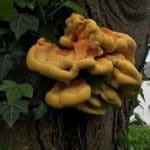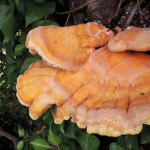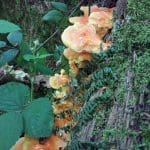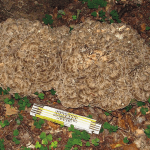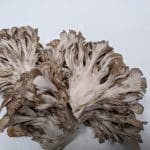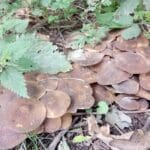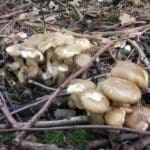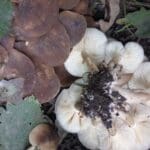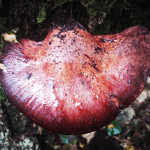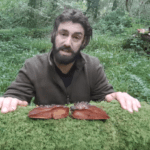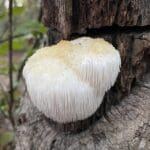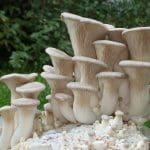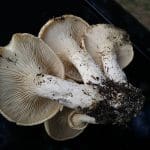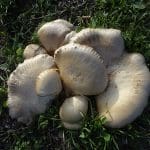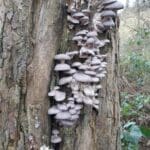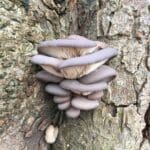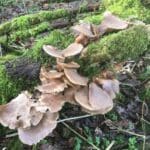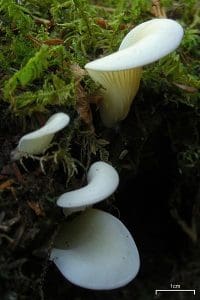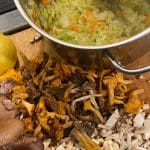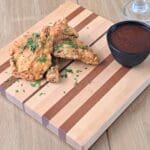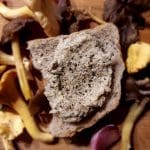Through this piece we’re going to take a look at why we may take a look and take interest in the trend for using mushrooms as meat.
Why swap and use Mushrooms as Meat?
Some vegetarians don’t believe in meat substitutes, saying, “you either don’t like meat – its flavour, texture and the ethical connotations – or you do”. But, if you’re like me and enjoy the flavour and texture but not the ethics, then meat substitutes, like mycoprotein (produced from the mycellium of the mould-like fungi, Fusarium venenatum), are a great addition to your diet. But mycoproteins are not the only solution. Actual mushrooms are a great meat substitute in their own right. They’re not pretending to be something they’re not, they have that delicious umami flavour and a satisfying bite. They’re versatile, easy to cook, low in calories and full of nutrition.
Details of the nutritional value of mushrooms compared to meat can be found further below; plus some handy tips on how to cook mushrooms. But first, let’s look at some of the best mushrooms you can forage for a meaty addition to your everyday basket:
And a couple that you shouldn’t or can’t forage but can grow or buy:
- Lion’s Mane mushroom
- King Oyster.
Lets Take a Look at what species of Mushrooms as Meat work!
Although I’m certain nearly all mushrooms can be used as a meaty like substitute, when cooked well even store bought mushrooms work really well for a meat free bolognese, we’re going to take a look at the wild species I think work best.
Chicken of the woods/Sulphur Polypore, Laetiporus sulphureus
Quite arguably the best use for Mushrooms as Meat.
This is a lemon-yellow to yellow-orange, fan shaped or irregularly semicircular bracket fungus, 10-40cm across. It often grows in tiers, most often on deciduous trees, commonly oak but also found on Yew, Cherry, Sweet Chestnut and Willow. It usually appears in September but can be found from late Spring in some years, depending on the weather.
When young and in good condition it is succulent, exuding a yellow juice when squeezed. The best part is the edges of the tiers. Further in it is tough and relatively tasteless. Just take a few slices from the edge and leave the rest to produce spores. It really does taste like chicken and is great fried in butter for 5 – 10 minutes. It becomes sour when its older.
It is believed that 10% of people experience an allergic reaction to Chicken of the Woods, so just try a little bit initially, to check if you are one of that 10%. If found growing on Yew, which is poisonous, be very careful to clean it thoroughly before cooking to remove every trace of Yew wood, bark and foliage that was incorporated into the mushroom’s flesh as it grew. Even dry, dead Yew tree matter is dangerously poisonous.
Full ID guide to Chicken of the woods
Chicken of the woods nuggets recipe
Hen of the woods, Grifola frondosa
Not related to Chicken of the Woods but still a bracket fungus, this has been described as looking like a brooding hen sat under an Oak tree. Most commonly found at the base of Oak trees, frequently on Beech and occasionally Hazel and Sweet Chestnut, usually late summer to autumn. Its large, 15 – 40cm tiers grow in leaf-like caps, each 4 – 10cm across and 0.5 – 1cm thick, from a repeatedly branching stem. The upper surface of the tiers are yellow and grey-brown, radially wrinkled, wavy and split at the white-edged margins; underneath they are white, becoming yellow. The texture is very meaty and best grilled or sautéed. It can also be dried and used as a flavouring. The flavour becomes acrid and the flesh fibrous with age, when it also attracts maggots.
Full ID guide to Hen of the Woods
Giant Polypore, Meripilus giganteus
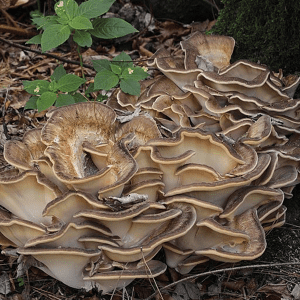
This is closely related to Hen of the Woods but is much larger with a fruit body 50 – 80cm across. The numerous, flattened, fan-shaped caps, each 10 – 30cm across and 1 – 2cm thick, arise in rosettes on short stems with a common base.
The upper surface of the caps is concentrically zoned with light browns, darker browns, yellows and reds, radially wrinkled and covered in fine brown scales; underneath they are white, then yellow, easily bruising to black.
It is found either at the base of deciduous trees or tree stumps – usually Beech but sometimes Oak – or arising from the roots some distance from the tree, which, being parasitic, the Giant Polypore will eventually kill.
The flesh very quickly becomes tough and bitter to eat. Very young ones are surprisingly good fried in either olive oil or butter with a dash of soy sauce.
Full ID Guide to Giant Polypore
Fried Chicken Mushroom/Clustered Domecap, Lyophyllum decastes
These are ‘standard’ mushrooms with a central stem, cap and gills, rather than the bracket fungus with pores, described above. The cap is grey-brown to brown, with silky or silvery streaks, 4 – 10cm across; they are often irregular shaped, convex at first then expanding to curve in or out at the wavy margin. The stem is contrastingly white, often bent and twisted along its 3 – 10cm length and becoming brownish towards the base. The gills are white to greyish, sometimes getting brown speckles as they get damage and age. They have white spores, and conveniently often spore print on each other due to the dense overlapping clusters. They can be confused with some potentially very dangerous fibrecaps, so please check every ID feature carefully, especially the smell and the spore print. and if in doubt, leave it out.
Chicken Mushroom forms dense clusters on open woodland floors, grassland, paths, cemeteries, waste ground and gardens in summer and autumn. They smell and taste mildly of chicken and are best sautéd. They can be dried or frozen cooked and are excellent preserved in olive oil.
Full ID guide for Fried Chicken mushroom
Beefsteak Fungus, Fistulinaceae
This is a small family of mushrooms with only one notable European member: Fistulina hepatica
Another bracket fungus, this is a bit deceptive because, although it looks, feels and bleeds like a slab of liver (hence ‘hepatica’), it actually tastes more like a fruit. Opinions vary. Some say it is best used raw, as a centrepiece of an exotic salad, but only when young and fresh because older specimens contain more tannin. Others are put off by the rubbery texture and recommend using milder flavoured, more mature specimens – removing the outer skin, slicing it into steaks to be soaked in milk for a few hours before frying and using in a stew with other, more flavoursome ingredients; adding the pink, milky juice at an appropriate moment. Alternatively, you can finely chop it and make it into a consommé, with stock, or rip it into chunks and briefly sauté or cook it slowly with onion and parsley.
Notable features are that the fruit body is almost spherical, 5 – 28cm across and 2 – 6cm thick, becoming kidney-shaped. The upper surface is pale reddish and appears velvety but is sticky and slightly rough; soon becoming radially grooved. The lower surface is white or yellow, bruising red to brown. The succulent, mottled-pink flesh with lighter veining, sometimes exuding blood-like droplets, adds to the meaty appearance of this fungus.
Beafsteak is parasitic on Oak and sometimes Chestnut. Usually found at the base of tree trunks in late summer to autumn. As well as edible value it has some economic value to the furniture industry because oak timber infected with the parasitic Beafsteak fungus is a darker, richer colour than normal.
Full ID guide to Beefsteak fungi
Lion’s Mane Fungus/Bearded Tooth, Hericium erinaceus
This is a protected species, listed as vulnerable on the Red List of conserved species on the Biodiversity Action Plan. It should not be collected or disturbed in the wild, but is cultivated for food and can be found, dried in delicatessens or even grown at home. The first thing that came up when I Googled this mushroom was a powder which eliminates brain fog and improves memory & concentration!
The fruit body is a whitish, solid cushion giving rise to spines up to 6cm long; discolouring with age. It is found in scars on live deciduous trees, especially Beech, in late summer to autumn.
Full ID Guide to Lion’s Mane fungus
King Oyster, Pleurotus eryngii
Sadly, you won’t find these growing wild in the UK. They are native to the Mediterranean regions of Europe, the Middle East, and Africa and are cultivated widely throughout Asia. They are renowned for their dense, meaty texture and depth of savoury flavour; often listed on restaurant menus as ‘mushroom steaks’ or ‘vegan scallops’.
We do have some edible oyster mushrooms in the UK which have a soft, fibrous flesh and definitely worth trying. They almost always grow on dead wood and it is their shell-like appearance that gives them their name.
Full ID guide for Grey Oyster mushrooms
There are a few inedible species with a similar growth habit and general shape but generally smaller. These are the Oysterlings which are easily identified as such by gills that turn brown from their brown spores.
An unrelated but similar species is Angel Wings, Pleurocybella porrigens, found in the north of the UK, mainly Scotland. These are potentially deadly, so please familiarise yourself with the differences between them and pale oyster mushrooms
Nutritional Value of Mushrooms Compared to Meat
Experiments on rats in the first half of the 20th Century concluded that a diet consisting of mushroom protein alone is nutritionally inadequate. The conclusion was based on the weight loss experienced by the rats eating mushrooms as compared to those who ate meat. It was recommended that, if you were to replace meat with mushrooms in your diet, you should include other protein sources as well. However, more recent studies suggest that might be just because mushrooms have a lower calorific value.
The information in Box 1, below, was taken from research, carried out in 2002, into the real nutritional value of fungi and its potential in combating anticipated world food shortages. This refers to mushrooms as a food group as a whole. The actual vitamin and mineral content varies between different species of mushrooms.
Tables 1-3 are a comparison of the nutritional value of different types of meat and raw mushrooms. The mushrooms involved were the cultivated button mushrooms we find in supermarkets and green grocers and the information was compiled in 2023 using data from the USDA food database.
Summary of the data
Protein
At first sight it appears that mushrooms are much lower in protein than meat. However, the amount of protein per 100 calories in mushrooms is comparable to most meats. It’s actually higher than in fatty meats such as ham and pork chops. The only meat sources with more protein per 100 calories are the super lean ones like chicken breast.
Vitamins and Minerals
Looking at Table 3, mushrooms have a comparable amount, or more, of many vitamins and minerals. If you adjusted these values on a per calorie basis, mushrooms would have more of just about every nutrient by a significant margin.
Without mentioning the cruelty-free and environmentally more sound aspects of swapping meat for mushrooms, I, personally will be brushing up my mushroom ID skills and checking out the map for likely spots to find these meaty morsels. I hope you will too :P) If so, you might also like a few tips on the best way to cook mushrooms.
Cooking Mushrooms
Start by rinsing your mushrooms under cold water to remove dirt and patting them dry with a kitchen towel. Don’t do this with lion’s mane, though; it can absorb a lot of liquid. Instead, use your hands or a damp paper towel to brush dirt off before cooking.
Frying or dry frying mushrooms in a hot pan is the best way to bring out the umami flavour in mushrooms.
- Its important not to over-crowd the mushrooms. Use a pan big enough to allow each mushroom space so that water evaporating from one mushroom doesn’t get absorbed by its neighbours – this stops the mushrooms getting soggy and slimy
- Put a little oil (or no oil, if that’s your thing) in the pan, and heat it up
- Add the mushrooms and cook, stirring occasionally, until the liquid evaporates and they start to brown
- Remove from the pan, and set the mushrooms aside until you’re ready to add them to your recipe
Delicate types of mushrooms can overcook quickly, so you really need to watch them closely.
The Data
Sources:
https://ods.od.nih.gov/factsheets
http://www.davidmoore.org.uk/Sec04_12.htm
| Box 1
Nutritional value of mushrooms as a food group as a whole: |
|
|
|
|
Table 1
| Protein Source | Protein (g) per 100g | Protein (g) per 100 calories |
| Bacon | 35.7 | 6.5 |
| Chicken breast | 32.1 | 20.3 |
| Chicken | 25.9 | 8.6 |
| Lean steak | 23.1 | 19.7 |
| Pork chop | 21.9 | 6.8 |
| Ham | 21.6 | 8.9 |
| Ground beef | 20 | 11.4 |
| Mushrooms (raw) | 3.09 | 14.04 |
Table 2.
All data is per 100 grams (raw mushrooms, but cooked meat).
| Mushrooms | Ground Beef | Chicken Breast | |
| Energy (kcal) | 22 | 176 | 158 |
| Protein (g) | 3.1 | 20.0 | 32.1 |
| Total Lipid (g) | 0.3 | 10.0 | 3.2 |
| Carbohydrate (g) | 3.3 | 0.0 | 0.0 |
| Fiber (g) | 1.0 | 0.0 | 0.0 |
| Sugars (g) | 2.0 | 0.0 | 0.0 |
Table 3
| RDA | Mushrooms | Ground Beef | Chicken Breast | |
| Vitamin B-12 (µg) | 2.4 | 0.0 | 2.2 | N/A |
| Vitamin B-6 (mg) | 1.3 | 0.1 | 0.4 | 0.9 |
| Niacin (mg) | 16 | 3.6 | 5.1 | 9.5 |
| Selenium (µg) | 55 | 9.3 | 16.6 | 31.9 |
| Vitamin D (µg) | 15 | 7.0 | 3.0 | N/A |
| Zinc (mg) | 11 | 0.5 | 4.8 | 1.0 |
| Phosphorus (mg) | 700 | 86.0 | 184.0 | 241.0 |
| Riboflavin (mg) | 1.3 | 0.4 | 0.2 | 0.2 |
| Potassium (mg) | 2000 | 318.0 | 321.0 | 343.0 |
| Iron (mg) | 18 | 0.5 | 2.2 | 0.5 |
| Choline (mg) | 550 | 17.3 | 66.1 | N/A |
| Magnesium (mg) | 400 | 9.0 | 20.0 | 32.0 |
| Thiamin (mg) | 1.2 | 0.1 | 0.0 | 0.1 |
| Sodium (mg) | 1500 | 5.0 | 66.0 | 47.0 |
| Folate (µg) | 400 | 17.0 | 6.0 | N/A |
| Manganese (mg) | 2.3 | 0.0 | 0.0 | 0.0 |
| Vitamin C (mg) | 90 | 2.1 | 0.0 | 0.0 |
| Calcium (mg) | 1200 | 3.0 | 12.0 | 6.0 |
| Vitamin E (mg) | 15 | 0.0 | 0.2 | N/A |
| Vitamin K (µg) | 75 | 1.0 | 0.8 | N/A |
| Copper (mg) | 900 | 0.3 | 0.1 | 0.0 |
| Vitamin A (µg) | 900 | 0.0 | 4.0 | N/A |
Find Wild Mushroom recipes here



